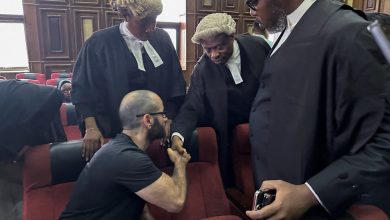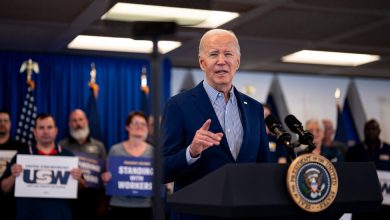Police Brutality Is Not Always About Race

The brutal killing of Tyre Nichols by Memphis cops horrified and infuriated many Americans, not least because it was another in what has been an endless litany of Black men and boys killed by police officers in America: George Floyd, Eric Garner, Philando Castile, Tamir Rice, Michael Brown and literally thousands of names less well known. There is one confounding detail in Nichols’s death, however. The five policemen who mercilessly beat the life out of him were all Black.
Thus, to understand the full tragedy of Tyre Nichols, it is important to ask hard questions about the culture and behavior of police officers — including grappling with the fact that whatever role race played in Nichols’s death, it was more complicated than the racist-white-cop-kills-Black-man framework into which we typically sort such horrific episodes. One possibility that needs further exploration is the role that poverty plays in determining the victims of police killings — a characteristic that overlaps with, but is obviously distinct from, race.
Much of the conversation about police violence in recent years has been through a lens focused on systemic racism, white cops and antiracism reform goals. But a man (or a woman) who is killed by a police officer merits our attention and response regardless of the race of either victim or killer. There has long been a theory afoot that hiring more Black cops would result in fewer shootings of Black civilians. But there is little evidence that this intuitive solution has any meaningful effect. (It’s worth noting here that there is substantially more readily available data regarding the race of victims of police violence than that of the perpetrators.)
More than one study has suggested that the difference in likelihood between white and Black cops killing Black people is much smaller than one might suppose; expert observers on the subject regularly concur; and it is a commonplace in Black community discussions that one cannot necessarily expect any particular clemency from Black officers in tough situations. The Memphis Police Department is 58 percent Black and has a Black police chief; that did not prevent the horrific acts of violence perpetrated on Nichols.
As Duane Loynes Sr., an assistant professor of urban and Africana studies at Rhodes College in Memphis, told The Los Angeles Times’s Jaweed Kaleem, “Here’s a dirty little secret: Studies indicate that Black officers are just as brutal and at times even more brutal against Black bodies as their white counterparts.”
The point is not that we don’t have a grievous problem, but rather that the problem is not exclusively racist white cops. It’s cops, period. (An important note: When it comes to nonlethal mistreatment, as opposed to police shootings, studies demonstrate the existence of outright racial bias. This is very much a problem, but a very different problem from police killings.)
The way we are trained to view the situation is understandable, but outdated. As recently as the 1970s and 1980s, cops killed people — Black and white alike — at much higher rates in major cities than they do now, as the criminologist Peter Moskos has shown. I grew up in the Philadelphia of that era, where Mayor Frank Rizzo openly condoned cops’ brutality against Black people. By morbid coincidence, I saw the gruesome videotaped beating of Nichols shortly after I rewatched Melvin Van Peebles’ pioneering 1971 film “Sweet Sweetback’s Baadasssss Song.” In the movie, Van Peebles plays a Black man on the run from racist white cops whose shameless, bloodletting brutality roughly corresponded to what some Black people of the period actually experienced. A lot of time has passed since then, but the way we discuss police brutality against Black people today can sometimes make it sound as if there is no difference between the situation Van Peebles depicted — of marauding, openly racist cops — and the one we face today.
Yet white Americans are also killed by police officers in appalling numbers — many more, overall, than Black Americans, owing to the fact that the latter make up only about 14 percent of the U.S. population. In 2022, The Washington Post’s database on cop killings documented that of 755 victims whose race was known, 225 were Black and 389 were white.
Because casual and sometimes lethal violence against Black people by cops is part of our shameful and still recent national narrative, names like those of the victims I cited earlier sometimes become national news stories. But the media rarely even covers police killings of white people, which don’t fit so neatly into that pre-existing narrative.
So we largely missed the story that in 2015 in Paradise, Calif., the white officer Patrick Feaster shot the white Andrew Thomas as he was getting out of the S.U.V. he had crashed during a pursuit, even as Thomas’s wife lay gravely injured on the ground at the scene. The parallel with what happened to Nichols is ghastly, as is that between George Floyd’s murder and what happened in 2016 to the white Tony Timpa in Dallas. Although Timpa had requested police officers’ help because he was off his medication, he was killed when they pinned him to the ground as he called out desperately. It was recorded on the officers’ body cams. Members of Timpa’s family have contacted me wondering why the media had so little interest in what happened to him; meanwhile, last year, the officer who had pinned him was promoted.
A common response here is to note that nevertheless, police officers kill unarmed Black people at more than three times the rate they kill unarmed white people, and that this disproportionate rate of Black killings demonstrates that racism affects whether cops kill. But this assumption seems oversimplified. One reason is that poverty also helps determine whether, and in what way, with what results, one encounters the cops.
The police are called to, as well as directed to, poorer neighborhoods more often than to middle-class or affluent ones. Poverty can nudge a person into criminal activities — including intrinsically violent ones, such as the illegal drug trade — that are far more likely to lead to dangerous encounters with cops. It is also not an accident that so many of these gruesome killings by cops happen when someone flees after being stopped because he already has an outstanding warrant. Such warrants are frequently outstanding as a result of poverty.
And in a striking parallel, unarmed Black people are not only more than three times as likely to be killed by a cop but also more than twice as likely to be poor. In 2021, the poverty rate for white Americans was 8.1 percent, while for Black Americans it was 19.5 percent.
We could propose that the match between these statistics bears no relevance to the issue of police violence and racism and dismiss them as a coincidence. But this would be willfully resistant to examining the significance of patterns in a way that no one would even venture in drawing parallels between, for example, poverty rates and obesity.
Police killings of unarmed or unthreatening American citizens are a national disgrace, and one that requires action. But action requires comprehension, and the simplest explanation — “racist white cops kill Black people” — is clearly often not the correct one.
John McWhorter (@JohnHMcWhorter) is an associate professor of linguistics at Columbia University. He is the author of “Nine Nasty Words: English in the Gutter: Then, Now and Forever” and, most recently, “Woke Racism: How a New Religion Has Betrayed Black America.”



